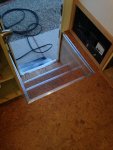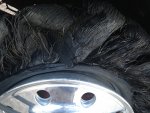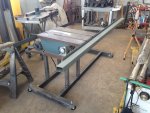Galvanic corrosion is often a misunderstood topic. I am very familiar with it when it comes to salt water. Less in atmosphere.
If you have two dissimilar metals that are electrically connected in an electrolyte, you create a battery. This battery drives electrons to one pole of the battery which causes oxidation at the anode. The anode starts to corrode faster. Incidentally, the other pole is protected.
The further apart two metals are on the galvanic series (google it for reference), the higher the voltage potential. Also, the stronger the electrolyte the greater the corrosion. If you are running a water through your pipes, you may have galvanic corrosion.
Also, the proximity of the materials to each other affect the corrosion rate. Think of it like you have a resistor between your poles in your battery. The further apart the dissimilar metals are the higher the resistor you have. If you put insulators between your materials, it is even better. If you reduce the exposed area of your materials it is also better.
Materials that passivate, like stainless, aluminum, titanium, etc..... have two values depending on if they are passive or active.
In the atmosphere, galvanic potential can increase the corrosion rate, but it is less of a problem.
I generally look at where the material is going to be and then decide if I really care. If your pipes are inside your camper, and used for gas, you may not have any issues for years. You could also paint the pipes. Inside the pipes you may condense water possibly, but how many years would it take to be a problem? Also, corrosion is a naturally occurring event. You may get corrosion regardless of galvanic potential.
I always find it odd that camper builders are always harping on isolating aluminum skins from steel frames. They will paint the aluminum and steel, then use sikaflex between them. Then take additional effort to isolate the materials with spacers and tapes. The aluminum is the anode in this case, the galvanic potential is relatively low, and all surfaces are painted and separated by glue. That should be enough. Adding tapes and setting spacers to me is just more work. If you see corrosion, it is probably due to a gap in the paint, and probably only matters if the steel is rusting. Or, where a rivet is, there is exposed metal due to drilling a hole. I would wager that most times the problem is caused by excessive numbers of rivets that are poorly sealed. A decent quality aluminum skin should passivate itself unless you are simply in a very corrosive environment. Then the environment is the problem more than the materials. Just my two cents.
Corrosion is often hated because it looks bad. Functionally it may or may not be a problem depending on the rate of corrosion, the amount of damage, the type of corrosion, and where it is.
By the way..... love the build. I look forward to the next one!
Sent from my iPhone using Tapatalk












